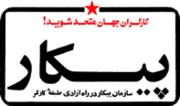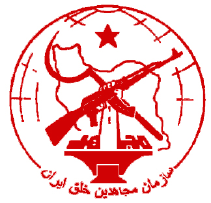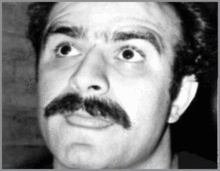Peykar
Organization of Struggle for the Emancipation of the Working Class | |
|---|---|
 Peykar's newspaper header including the slogan "Workers of the world, unite!" under the red star | |
| Leader | Alireza Sepasi-Ashtiani[1] and Hossein Rouhani[2] |
| Founded | 1975 |
| Dissolved | 1983[3] |
| Merger of | Some small Maoist groups and Marxist Mujahedin[4] |
| Split from | People's Mujahedin of Iran |
| Merged into | Communist Party of Iran[5] |
| Newspaper | Peykar |
| Membership (1980–1982) | Maximum 3,000 equipped with light weapons[6] |
| Ideology |
Marxism–Leninism[5] Trotskyism[7] Maoism[8] |
| Political position | Far-left[5] |
Organization of Struggle for the Emancipation of the Working Class (Persian: سازمان پیکار در راه آزادی طبقه کارگر, translit. Sāzmān-e peykār dar rāh-e āzādī-e ṭabaqa-ye kārgar) or simply Peykar (Persian: پيکار, lit. 'battle'), also called the Marxist Mojahedin, was a secular splinter group from the People's Mujahedin of Iran (PMoI), the largest of Iran's guerrilla groups. Its members broke away from the PMoI to support of secular Marxism Leninism, rather than the Leftist Islamist modernism of the People's Mujahedin. Founded in 1975, by the early 1980s Peykar was no longer considered active.
History


Mojahedin (ML) was founded in October 1975 when the majority of PMOI leaders who had not been imprisoned voted to accept Marxism and declare the organization Marxist-Leninist. At this time the group continued to call itself People's Mujahedin.[9] Their position was laid out in a pamphlet entitled Manifesto on Ideological Issues, where the group's central leadership declared "that after ten years of secret existence, four years of armed struggle, and two years of intense ideological rethinking, they had reached the conclusion that Marxism, not Islam, was the true revolutionary philosophy."
This meant two rival Mujahedins, each with its own publication, its own organization, and its own activities. This continued just before the 1979 Iranian Revolution when the Marxist Mojahedin changed its name to Peykar, on December 7, 1978 (16 Azar, 1357), the full name is: Organization of Struggle for the Emancipation of the Working Class. This name was after the "St. Petersburg League of Struggle for the Emancipation of the Working Class", which was a left wing group in St. Petersburg, Russia. It was founded by Lenin in the autumn of 1895.[10]
Mujtabi Taleqani, son of Ayatollah Taleqani, was one of the PMOI who "converted" to Marxism. Hossein Ruhani was another prominent Peykar member. He ran for Majles candidate in Tehran, and caused a major scandal in 1980 by divulging for the first time secret PMoI negotiations with Ayatollah Khomeini. Ruhani also made Peykar "the first left-wing organization to personally criticize Khomeini", when he called Khomeini a "mediaeval obscurantist" and his regime "reactionary" and "fascistic." Later Ruhani was arrested and imprisoned. In May 1982 he appeared on television as one of the first of numerous opponents of the regime to recant their opposition in what is widely thought to have been the work of prison torture. Ruhani denounced his membership in Peykar, praised "the Imam" Khomeini and proclaimed that he felt freer in prison than "in the outside world."[11]
Peykar was operationally active in the early 1980s, mostly conducting small-scale insurgency-style raids in Northern Iran, though the group was also responsible for one hostage situation at the Iranian consulate in Geneva in 1982.[12] Peykar suffered after the Mujahedin June 1981 uprising, which it did not support but whose members were "arrested and executed en masse" afterwards nonetheless.[9] According to MIPT, Peykar "can be considered inactive, as its members are assumed to have been reintegrated into the MeK or other anti-Ayatollah opposition groups in the early to mid-1980s."
There are two other small groups as offshoot of the Peykar, which are Nabard and Arman.
See also
References
- ↑ Maziar, Behrooz (2000). Rebels With A Cause: The Failure of the Left in Iran. I.B.Tauris. p. 72. ISBN 1860646301.
- ↑ Abrahamian, Ervand (1999). Tortured Confessions: Prisons and Public Recantations in Modern Iran. University of California Press. p. 150. ISBN 0520922905.
- ↑ Mirsepassi, Ali (2004), The Tragedy of the Iranian Left, RoutledgeCurzon, Table 10.2 Characteristics of principal secular left-wing organizations, 1979–83
- ↑ Vahabzadeh, Peyman (2010). Guerrilla Odyssey: Modernization, Secularism, Democracy, and the Fadai Period of National Liberation In Iran, 1971-1979. Syracuse University Press. p. 173–174.
- 1 2 3 Ḥaqšenās, Torāb (October 27, 2011) [December 15, 1992]. "COMMUNISM iii. In Persia after 1953". In Yarshater, Ehsan. Encyclopædia Iranica. Fasc. 1. VI. New York City: Bibliotheca Persica Press. pp. 105–112. Retrieved September 12, 2016.
- ↑ Razoux, Pierre (2015). The Iran-Iraq War. Hrvard University Press. Appendix E: Armed Opposition. ISBN 9780674915718.
- ↑ Sepehr Zabir (2011). Iran Since the Revolution (RLE Iran A). Routledge. p. 140. ISBN 978-0-415-61069-8.
- ↑ Jebnoun, Noureddine; Kia, Mehrdad; Kirk, Mimi, eds. (2013). Modern Middle East Authoritarianism: Roots, Ramifications, and Crisis. Routledge. p. 72. ISBN 9781135007317.
- 1 2 Abrahamian, Ervand, Tortured Confessions, University of California Press, (1999), p.151
- ↑ Iran Between Two Revolutions by Ervand Abrahamian, Princeton University Press, 1982, p.493-4
- ↑ Abrahamian, Ervand, Tortured Confessions, University of California Press, (1999), p.151-2
- ↑ MIPT Terrorism Knowledge Base. Peykar